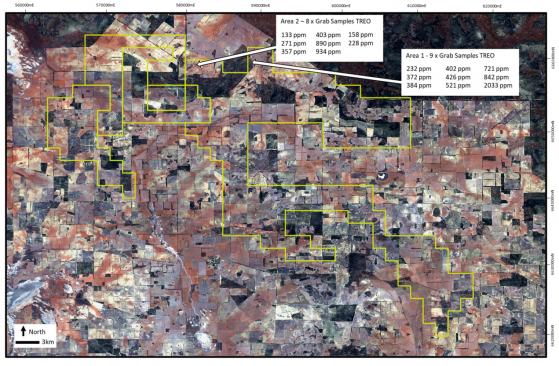Corella Resources Ltd (ASX:CR9) shares were trading about 9% higher intra-day at 2.5 cents after discovering two distinct styles of rare earth element (REE) mineralisation at its 100% owned Tampu Project in the Yilgarn region, Western Australia.
The company’s reconnaissance exploration has revealed promising results from rock-chip sampling, including:
- A carbonatite-related mineralisation signature with rock-chips up to 2,033ppm TREO (total rare earth oxides) and a high valuable heavy rare earth (HREE) ratio of up to 39%; and
- pegmatite-hosted mineralisation/anomalism with results up to 934ppm TREO.
Corella CEO Jess Maddren said: “Corella Resources remains committed to delivering value to its stakeholders through active exploration, strategic decision-making, and a pursuit to unlock the untapped potential within the Yilgarn region.
“These first pass exploration results are encouraging, they support other styles of mineralisation and occur in a relatively unexplored region.”
Tampu granted tenure in yellow with grab sample results for REE analysis (TREO).
The company has also lodged three new and strategic Exploration Licence Applications (E70/6578, E70/6579 & E70/6592), increasing the company’s total land holding by 110% to 1,922 square kilometres at the Tampu Project.
Corella is s planning an exploration program for early 2024, focusing on testing geophysical and hyperspectral targets associated with the REE mineralisation across its extensive tenements.
The program includes plans for RC (reverse circulation) drilling, with a program of works application currently in progress with DMIRS (Department of Energy, Mines, Industry Regulation and Safety).
“Lot more than just granite”
Maddren added: “Corella intends to leverage of its first mover advantage and dominant landholding in the region, which has seen the arrival of the likes of RioTinto and IGO pegging ground as our neighbours.
“There is a lot more than just granite out here in this part of the Wheatbelt!”
Background
Studies have been progressing across the unexplored areas of the Yilgarn region by the Centre for Exploration Targeting and Geoscience Australia over the last decade to understand the structural setting and areas for prospective critical minerals.
Notable mining companies such as Rio Tinto (ASX:RIO) and IGO have more recently pegged exploration licences directly adjacent to the Corella Resources tenements.
Map of existing Corella tenements, new Corella tenements and surrounding tenement holding.
A comprehensive desktop review of Corella's tenements, conducted by the experienced geological team, has revealed significant potential for extended kaolin areas as well as potential for other mineralisation.
Read: Corella Resources presses on with “Australia’s best specification bright white kaolin deposit for HPA”
Initial field investigations and sample collections have returned positive assays for REE prospectivity in potential carbonatites and pegmatites.
Further, recent exploration by others in the region has also uncovered potential clay-hosted REE mineralisation associated with weathering of granitoid bodies.
Rock chip results
Corella used a portable XRF to analyse, obtain, and shortlist rock chip samples to be sent for full laboratory analysis.
Various chemical groupings can be seen in the results with at least two populations of REE bearing pegmatite chemistry and REE bearing carbonate/carbonatite.
The carbonate/carbonatite samples contain CaO+MgO results of 39.16% and 44.64% and elevated strontium of 943 and 1235ppm.
The suite of REE differed between the chemistries with the pegmatite hosting a higher percentage of light rare earths (79-88% of TREO) compared to the carbonatite and the carbonatite having a higher heavy rare earth (34- 39% of TREO).
The carbonate bearing rocks also notably had the highest TREO result of 2033ppm.
Neodymium and praseodymium comprised 12-26% of the TREO. Neodymium ranges from 15.2ppm to 388ppm and praseodymium ranges from 5.03ppm to 101.5ppm.
Read more on Proactive Investors AU
